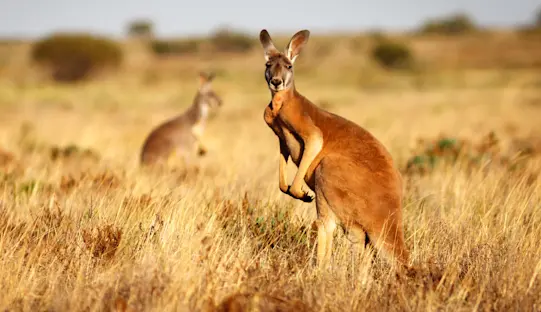Growing up on the Gulf Coast of Florida, manatees were part of our lives. We’d see them in marinas and on school field trips. I remember one day near the end of high school, studying for an exam in a sun lounger in the backyard when I heard the whoosh of a manatee blowing as it surfaced. I looked down to see its whiskered snout just a few feet away, sniffing like a dog’s does in the wind. He or she approached the seawall to get as close as possible, looking straight at me before ambling away toward our neighbors.
Recently, on a stopover in Doha, Qatar, I saw three different outdoor art installations depicting animals that looked remarkably like manatees but with fluked tails like a whale or dolphin. I wondered,
“What is swimming in the waters off Qatar and how similar are they to manatees off the Florida coast?”

Dugong
Dugongs of the Persian Gulf
The Persian Gulf is home to the second-largest dugong population in the world, which is largely concentrated on the southern coast between Doha and Abu Dhabi.
The dugong is one of four living species of the order Sirenia, which also includes manatees. It is the only living representative of the once-diverse family Dugongidae; its closest modern relative, the Steller’s sea cow, was discovered in 1741 and hunted to extinction by 1768. That species lived primarily in the Commander Islands of the western Bering Sea.
The current population of dugongs in the Persian Gulf is estimated to be between 5,000 and 7,000 individuals. In the region, dugongs can be found in the territorial waters of Bahrain, Qatar, Saudi Arabia and the United Arab Emirates.

Dugong
Mammals of the order Sirenia
Their name—Sirenia—comes from the Sirens of Greek mythology who lured sailors with their songs. These gentle giants of the sea captivate us, though, with their serene demeanor. Despite their obvious similarities, manatees and dugongs are distinct species with unique characteristics and habits.
Studies using biochemical analysis of proteins show that the closest modern relatives of sirenians are:
- elephants,
- aardvarks, and
- small mammals known as hyraxes.
These four orders of mammals are sometimes considered subungulates, meaning they may be evolutionary offshoots of a primitive ungulate (hoof) stock. The anatomical characteristics they share include the lack of a collar bone and the presence of nails instead of claws.
West Indian and West African manatees have very basic fingernails on their forelimbs. Amazonian manatees and dugongs do not have any nails.

Dugong
Physical Differences and Similarities between Dugongs and Manatees
At first glance, manatees and dugongs might seem identical. Both are large, aquatic mammals with rotund bodies adapted for a slow grazing lifestyle. Here are some similarities and differences:
- Their eyes are similar and their skin is gray, but may appear brown or green as algae grows on them because they move slowly.
- Neither dugongs nor manatees have dorsal fins. Their snouts are designed to feed on ocean grasses, but quite differently.
- Dugongs have short, broad, downward-facing, trunk-ish snouts that are horseshoe-shaped with a slit-like mouth. The snout ends with a cleft, a muscular lip that aids the dugong in its foraging for seagrass—because it is a strictly bottom-dwelling feeder.
- Manatees have shorter snouts, which means that they are able to gather food and feed on plants growing at or near the surface of the water.
- Another difference is that manatees have only six cervical vertebrae; all other mammal species except two types of sloth have seven.
- A dugong’s nostrils are further back on its head than they are on a manatee. Both are specially designed to be submerged in water. Dugongs’ nostrils act like valve openings on top of their heads; they open when they breach for air and close underwater.
- Perhaps the most noticeable physical difference between dugongs and manatees is their tail shape. Manatees have rounded, paddle-shaped tails, while dugongs have fluked tails.

Manatee
Appearance and Size of Manatees and Dugongs
In terms of size, dugongs are generally smaller than manatees. Manatees grow to be approximately 8 to 13 feet long on average and weigh between 440 and 1,300 pounds. Dugongs, on the other hand, can reach 8 to 10 feet long and weigh between 510 and 1,000 pounds.
Although dugongs can weigh more than manatees, it is rare for a dugong to reach that size.
The smaller end of the range is typical for dugongs, which makes them appear slimmer and longer compared to manatees, as does their longer snout.

Manatee
Behavioral Differences between Manatees and Dugongs
Both dugongs and manatees are slow-moving creatures. Their feeding habits differ slightly. Dugongs’ diets consist entirely of seagrass. They use their upper lips to uproot the entire seagrass plant rather than eating only the leaves—this leads to dugong trails like sandy paths through seagrass beds. They have very slow metabolic rates, and when seagrass is scarce, they will also eat algae.
Manatees have a much more varied diet, consuming over 60 species of plants, including sea clover, kelp, algae, turtle grass, manatee grass, shoal grass, mangrove leaves, various algae, water hyacinth, acorns and hydrilla.

Manatee mother and calf
Population and Conservation of Manatees and Dugongs
The dugong population is estimated to be around 100,000, but it’s believed to be declining, with a worldwide decrease of 20% in the last 90 years.
Manatees, however, have seen a resurgence in recent years from very low numbers. In the United States, their population reached a low in the 1970s, with only a few hundred individuals. As of 2016, 6,250 manatees were reported swimming in Florida’s springs. The total population of manatees is estimated at more than 13,000.
The International Union for Conservation of Nature (IUCN) lists both manatees and dugongs as vulnerable species. Their populations face threats from habitat destruction, hunting, and fishing-related fatalities. With their long lifespans of around 70 years and slow rates of reproduction, these species are especially vulnerable to extinction.
Dugongs are especially vulnerable due to their long reproductive cycles. Female dugongs typically give birth for the first time at around 10 years of age and only breed roughly every three to six years. Female manatees typically have their first baby at age three and have more babies every two to three years.
After about a year-long pregnancy (up to 14 months for dugongs), both female manatees and dugongs birth calves that stay with them for around two years.
Dugongs are a social species found in groups that can vary in size from 2 to 200 individuals. Pairs of dugongs found together are often mother and calf. There is rarely enough seagrass to support large groups over a long time. As a result, dugongs are semi-nomadic; some will migrate long distances while others stay in the same area for life. Their travel is driven by the availability of seagrass.
Dugongs are known for being more wary of humans and harder to spot since they are bottom feeders. Manatees, though, very often interact with humans and live in populated areas.

Manatees
Range, Habitat and Distribution of Dugongs and Manatees
Both manatees and dugongs are found in warm tropical or subtropical waters, but their habitats do not overlap.
The dugong’s range is in the warm coastal waters of the Indian and Pacific oceans from East Africa to Australia. The largest dugong populations are in the following:
- Western and northern Australia’s Shark Bay and Moreton Bay
- On the western coast of Madagascar and along the coast of Mozambique
- Along the eastern coast of Africa
- in the Red Sea
- the Persian Gulf
- around the Indian subcontinent, and
- through the western Pacific Ocean.

Manatees
Subspecies of manatees inhabit:
- West Indian manatees (Florida & Antillean) are found in coastal areas of the Caribbean, the Gulf of Mexico, and the Amazon River from Florida to Brazil.
- Amazon manatees are found in the Brazilian Amazon Basin.
- West African manatees are found on the western coast of Africa from Mauritania in the north to Angola.
Both dugongs and manatees migrate as they graze, fragmenting the population into small groups throughout those regions.
Unlike dugongs, which stay in saltwater, manatees can live in fresh, salt, or brackish waters and like—even need—to drink fresh water.

Dugong
Where to Spot Dugong and Manatees
Dugongs’ range is much larger globally, but due to their behavior, they may be more difficult to spot.
Manatees, on the other hand, can be extremely easy to spot and interact within certain areas, especially warm springs in and around Florida during the winter months.
Florida is not the only place to spot manatees in the wild. WWF is working in places like Belize to protect seagrass beds and restore and protect key mangrove areas, and in Mexico through our Mangroves for Community and Climate program. By protecting coastal ecosystems, we are also preserving valuable habitat for manatees.
Most of the world’s dugong population now occurs in northern Australian waters between Shark Bay in Western Australia and Moreton Bay.
In the Philippines, dugong populations are fragmented, and in Taiwan and China, they have become locally extinct. Divers and fishermen report regular sightings in countries as varied as Borneo, Egypt, Vanuatu, and Sri Lanka.
Manatees and dugongs share many similarities but are distinct with unique characteristics and habits. Understanding these differences is crucial for their conservation and our continued enjoyment and protection of these fascinating mammals. As we continue to learn more about these gentle giants, we can better appreciate their role in our world’s diverse marine ecosystems.



































